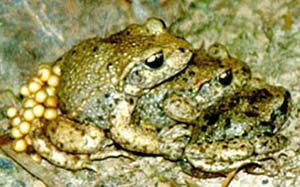Frogs die slowly because of climate change
A dangerous fungus associated with climate change is destroying large numbers of amphibians in Europe and can push some species to the brink of extinction, Spanish scientists said.
Frog frog spore Batrachochytrium dendrobatidis (BD) is a dangerous infectious agent in amphibians. When fungal infections, amphibians cannot control the process of dehydration and die.

Alytes obstetricans frogs.
( Photo: livingunderworld.org)
A 26-year study on Alytes obstetricans frogs in Penalara National Park (Spain) showed that the number of frogs infected with BD had a proportional relationship with the ambient temperature.
Earlier this year, scientists also found a similar link between the extinction status of frogs infected with BD in South America with increasing temperatures of the environment.
It has been suggested that BD fungi have destroyed a large number of frogs and their relatives in South America and Australia. Since 1980, BD has become extinct 74 of the 110 species of colored frogs in Central and South America.
Overflowing to Europe
BD started arriving in Europe a decade ago. Due to fungal infections, Alyte sobstetricans frogs on the mountains of Spain's Penalara National Park are now almost extinct.
Jaime Bosch, an expert at the National Museum of Natural Sciences in Madrid, collaborated with his colleagues to compare data on frog extinction in Penalara with geological data in the mountains they lived between 1976 and 2002. They found a close relationship between temperature rise and the extent of fungal action.
" This disease is the best and most obvious example of the relationship between climate change and an infectious disease ," said Matthew Fisher, a member of the research team.
According to Fisher, amphibians are cold-blooded animals. They are vulnerable to changes in the temperature of the living environment. The temperature fluctuation of the environment causes their bodies to lose their ability to protect themselves from disease. In addition, recent cold winters allow fungi to survive from year to year, something they previously could not do.
Protected areas are not a solution
" The decline in the number of amphibians, especially those living in areas that are not affected by humans, has been alarming since the 1970s, " said Alan Pounds, an ecologist in China. Monteverde Cloud Forest Conservation Center (Costa Rica), said.
"This situation shows that we cannot guarantee the existence of amphibians if only rely on national parks and protected areas."
Although experts are not sure why the fungus epidemic spread from one region to another at a very fast pace, there is evidence that the status of selling frogs as pets is one of the reasons. Between 1998 and 2002, it was assumed that the US alone imported 14.7 million frogs, frogs, toads and other amphibians.
Viet Linh
- Climate change can affect frog evolution
- This is how Dubai copes with climate change
- What is Climate Change?
- Marching for climate change around the world
- Find the culprit that extends 100 species of frogs
- Strangely, Vietnamese frogs suddenly change color when mating
- Strange frogs in the world
- The terrifying change of the Earth due to climate change
- SimCLIM helps build climate change scenarios
- Climate change is happening faster than expected
- Interesting findings: Colorful colors help frogs
- 4 shocking findings on climate change
 Animal 'suffering' after hibernation
Animal 'suffering' after hibernation Why do goats climb well?
Why do goats climb well? Scientists were surprised to see chimpanzees eating turtles
Scientists were surprised to see chimpanzees eating turtles Giant catfish died deadly due to drought in Thailand
Giant catfish died deadly due to drought in Thailand